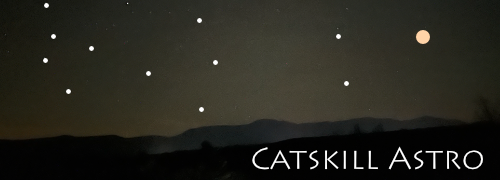Messier Objects
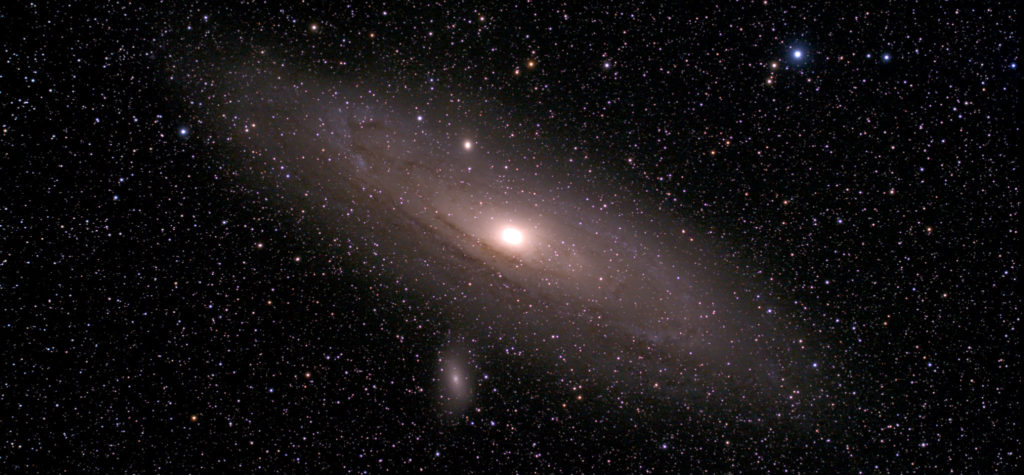
Page 5 of 11
Messier observations 41-50 of 110 total to date.
| Catalog # | Thumbnail | Title/link | Description |
|---|---|---|---|
| M41 | 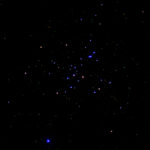 |
M41 / NGC 2287 / Little Beehive Cluster | This is a well known cluster, perhaps recorded by Aristotle [messier.seds.org] visible to the naked eye in dark skies at magnitude 4.65. Messier recorded it as follows: "(January 16, 1765) Cluster of stars below Sirius, near Rho Canis Majoris; this cluster appears nebulous in an ordinary telescope of one foot [FL]; it is nothing more than a cluster of small stars." <--> For me personally, this was the very last unobserved Messier object, completing all 110. The last 6 were all captured between 4 AM and 5:24, which was astronomical dawn. I was sort of sleepy, not having had any coffee, and nearly forgot it. Luckily it was an open cluster so I could capture it in a brief amount of time, though slight nebulosity surrounding the larger blue stars is evident. It's resemblance to a beehive, little or otherwise, escapes me. |
| M42 | 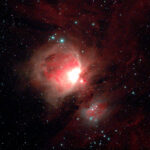 |
M42 / Great Orion Nebula / Sh2-281 | This was the first Messier catalog entry in more than 4 years, dated March 4, 1769, presumably motivated by the catalog's upcoming publication. "Position of the beautiful nebula in the sword of Orion, around the star Theta which ii contains [together] with three other smaller stars which one cannot see but with good instruments. Messier has entered into the great details in this great nebula; he has created a drawing, made with the greatest care, which one can see in the Memoirs of the Academy for 1771, plate VIII. It was Huygens who discovered it in 1656: it has been observed since by many astronomers". <--> For me, this was the last observation of a magical night. M42 is a gorgeous object, and one "everybody" does. I tried for a view that included a wider contrast range, in this featured image somewhat enhanced in Affinity Photo. Will add a few more images to the gallery, starting with a wide view of M42 and the Horsehead, taken with my Askar FMA180, plus a view with my C9.25 and f6.3 reducer. |
| M43 |  |
M43 / NGC 1982 | Recorded on the same date as M42, presumably as part of his publication push, Messier's entry explains: "(March 4, 1769) `Position of the little star surrounded by nebulosity & which is below the nebula of the sword of Orion. M. Messier has included it in the drawing of the Great [Nebula].'" <--> Frankly, I didn't know this bulb on top of M42 had its own Messier number until my quest to observe all 110. It is a "miniature" M42, birthing a single star. M42 has a long history, as it's really a naked eye object, but the nebulosity was discovered in the 17th century. M43 itself was described by Jean-Jacques d'Ortous de Mairan circa 1731. The boundary separating it from M42 is the "northeast dust lane". This image shows it well, though my original target was M42 (see wide view). At the time the only telescope I owned was the EVO 9.25, and this was the widest view I could achieve at the time, focal length of roughly 1,500mm using a reducer. I've always thought it resembles one of the non-edible berries on bushes from my childhood, which I discover now is an English Yew Tree.... see gallery. |
| M44 |  |
M44 / Beehive Cluster | This was the third of four entries in Messier's pre-publication push, a naked-eye cluster that has been known since antiquity. Messier's entry: "(March 4, 1769) `Cluster of stars known by the name of the nebula in Cancer.'" <--> This was one of my favorite binocular targets in March of 23 when I was without a telescope. In binoculars, this is a reasonably "dense" target. It was my first experience of finding a target using a map and my wits rather than a computerized GoTo mount, and I enjoyed it immensely. Frankly, it looks more convincingly like a beehive in binoculars than it does in this image. |
| M45 | 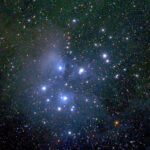 |
M45 / Pleiades | The fourth and final addition to the catalog that Messier made pre-publication: "(March 4, 1769) `A cluster of stars, known by the name of the Pleiades. The position reported is that of the star Alcyone.'" This is an obvious, naked-object known since ancient times. <--> The Pleiades was the first asterism I ever noticed, myself. Walking home at night when I was 10 or so, I saw the seven sisters formation and decided it had to be UFOs. Someone set me straight, and I learned their name, Pleiades, but I loved them still. Through a telescope they're even more wonderful because of the dramatic nebulosity that surrounds the major stars. This first observation through a telescope was at 270mm, but I have added a second observation, Dec 12, 2023, 15m30s to the gallery, taken with the Askar V at 600mm. Interestingly, the "seven" sisters has only six naked-eye objects visible. It is believed that the seventh sister was an optical binary that has shifted relative position so it is no longer visible. |
| M46 |  |
M46 / NGC 2437 / NGC 2438 | Messier 46 (M46, NGC 2437) was the first object Charles Messier discovered (his 19th so far) after he had published the first edition of his list (M1-M45). He added this one to his catalog on February 19, 1771, three days after presenting it to the academy, together with three more Messier objects, M47, M48, and M49. [messier.seds.org]. These entries are much more typical of his 1764 work, compared to the pre-publication "eye candy" of M41-M45. Messier's entry does not reference the planetary nebula, except indirectly: `A cluster of very small stars, between the head of the Great Dog and the two hind feet of the Unicorn.... [O]ne cannot see these stars but with a good refractor; the cluster contains a bit of nebulosity.' This represents a gap of nearly two years since he'd added M41-45. <--> Beautiful, small planetary nebula NGC 2438 was my primary target, embedded within the lovely open cluster, M46. Lovely capture: the planetary nebula is bright enough that you can capture it without blowing out the cluster. |
| M47 | 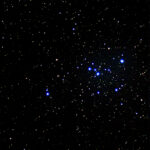 |
M47 / NGC 2422 | The second of four entries by Messier: "(February 19, 1771) `Cluster of stars, little distant from the preceding [M46]; the stars are greater [brighter].... The cluster contains no nebulosity.' " This was considered an independent discovery by Messier who was not aware it had been described before 1654 by Hodierna. It was also "lost" until 1959 when T.F. Morris recognized a sign error in Messier's original calculation (along with M48's). <--> From my perspective, this is a simple cluster (basically the brightest of the blue stars) on an interesting star field which I would never have considered observing if not for its inclusion on the Messier list. Having sought high profile additions just before publication, Messier appears to be a returning to the form of his 1764 entries. |
| M48 | 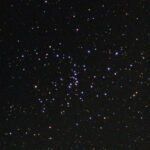 |
M48 / NGC 2548 | Messier's third entry on February 19, 1771, and a new discovery (#20 so far): "Cluster of very small [faint] stars, without nebulosity; this cluster is at a short distance from the three stars that form the beginning of the Unicorn's tail." As with M47, it was lost due to a calculation error that displaced the object by 5°. Caroline Herschel, sister of William, was the first to publish the object with the correct location in 1783, but did not associate it with M48. It was "found" by Oswald Thomas in 1934, and independently by T.F. Morris in 1959 who identified Messier's reversal of a sign in calculation. <--> I observed this because it was bright enough and far enough from the moon to image well, quickly. It's an attractive open cluster, but not an object I would ordinarily observe. |
| M49 | 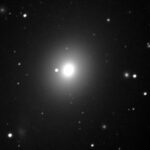 |
M49 / Arp 134 / NGC 4472 | This was the fourth and final addition, and another original discovery (#21), on February 19, 1771. It was also Messier's first elliptical galaxy in the catalog, though undoubtedly it would have appeared to him as a dim GC: "Nebula discovered near the star Rho Virginis. One cannot see it without difficulty with an ordinary telescope of 3.5-feet [FL]. The Comet of 1779 was compared by M. Messier with this nebula on April 22 and 23: The comet and the nebula had the same light. M. Messier has reported this nebula on the chart of the route of the comet, which appeared in the volume of the Academy of the same year 1779. Reviewed on April 10, 1781." <--> This galaxy was selected by Halton Arp for his atlas due to the "fragments" identified as the peculiar feature. The main fragment is visible on the 8 o'clock position just inside the lower left corner in the featured or comparison images. It's in the 4 o'clock position in the un-cropped captures, and particularly evident in my inverted image. It's clear an enormous amount of tidal flow exists between M49 and whatever this "fragment" is, presumably a distorted dwarf galaxy. Other fragments may also be visible, particularly in my inverted image, mostly on the opposite side of M49 within its outer halo. Also, find my original Seestar 11m capture in the gallery, as well as the annotation to its wider FOV. It does not have the resolution to show the Arp data but provides a nice view of M49 in context. |
| M50 | 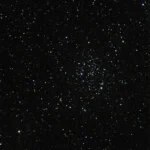 |
M50 / NGC 2323 / Heart Shaped Cluster | After more than a year's gap, Messier added this independent discovery on April 5, 1772. I've chosen to count discoveries where Messier's primacy is undisputed, and therefore am not counting this one. Messier's catalog notations are quite fulsome for him: "Cluster of small stars, more or less brilliant, above the right loins of the Unicorn, above the star Theta of the ear of Canis Major, & near a star of 7th magnitude. It was while observing the Comet of 1772 that M. Messier observed this cluster. He has reported it on the chart of that comet, on which its trace has been drawn. Mem. Acad. 1772." <--> This is another cluster low on the southern horizon. While the "heart" shape is evident, this is not a target I would pursue except for it's presence on the list. Captured on an early AM session to complete the last 6 Messier objects. |
